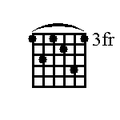Guitar/Barre Chords
Barre chords are chords that involve using one finger, usually your first finger, to press all the strings down at once on a single fret. Barring turns your first finger into a movable capo. You can then use your remaining three fingers to play open chord shapes, but in any position on the fretboard. Not all open chord shapes are easy to play with a barre, but once you have learned barring techniques, your chord vocabulary will increase and you will be able to play all along the fretboard.
Initially, barre chords are much more difficult to play than open chords. Before being able to play a barre chord, you first must train your hand be able to barre the fretboard. To do this, you take your first finger and press it lightly against the strings (applying no pressure) so that the finger covers all the strings along the same fret. Keep increasing the pressure until all the strings can be heard to sound clearly. A common mistake for beginners is to barre with full pressure which leads to hand fatigue. By lightly touching the strings and increasing the pressure in small increments, you will find that the pressure you need to apply to make the strings sound is much less than you imagine. Your thumb should be directly behind your first finger on the neck for full support. To illustrate the concept of a barre, compare the difference between the open strings (where the nut acts like a "zero" barre) and the full barre at the third fret.
Six String Barre Chord
[edit | edit source]A six string barre chord is a chord in which all the strings are being played. It can be compared to E chords, because, since the guitar is tuned to E, it effectively is an open barre chord. (you can view all open chords as a form of barre chords, which do not require you to press all the 6 strings somewhere [ because you use the open strings - 0 - hence their name ]. Let us examine the form of a major six string barre chord, in this case G, along with the major E chord:
In both of these chords, the relationship between the individual notes is identical, which is why the G chord is still a major chord. The difference is the root note, which determines the keys of the respective chords. By looking at the root note, we can see that the difference between all the notes of the E major and G major are three frets. But so long as the relationship remains the same, the major barre chord form can be played on any fret neck. For example, it could be played as an A major or a B major by putting it in these two positions:
The usefulness of barre chords comes from this ability to be played anywhere on the neck. Sliding the chord shape up and down the neck allows you to play many different chords relatively easily, and barre chords are a fundamental tool for rhythm guitarists since they can easily be used to create syncopated chord progressions.
As we saw earlier, the difference between a major and a minor chord is a flattened third. Using a barre chord, the transition between a major and a minor chord is relatively simple. The difference between an E major chord and E minor chord is the lifting of a single finger, thereby lowering the note by a semitone. With any barre chord that is formed using the E major shape, you can lift a single finger and play the corresponding minor chord. The minor barre chord form, shown beside the major barre chord form:
The same idea can be applied to seventh chords, or any other chord you can think of.
Five String Barre Chords
[edit | edit source]The same principles hold for five string barre chords, except instead of using the E chord shape, the A chord is used. Additionally, it should be emphasised that only five strings are played, which means that the low E string should not be allowed to sound.












